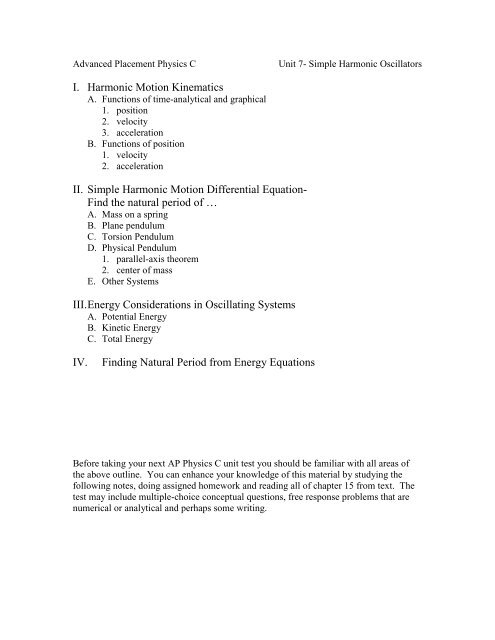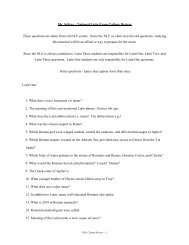I. Harmonic Motion Kinematics II. Simple Harmonic ... - Musowls
I. Harmonic Motion Kinematics II. Simple Harmonic ... - Musowls
I. Harmonic Motion Kinematics II. Simple Harmonic ... - Musowls
You also want an ePaper? Increase the reach of your titles
YUMPU automatically turns print PDFs into web optimized ePapers that Google loves.
Advanced Placement Physics C Unit 7- <strong>Simple</strong> <strong>Harmonic</strong> Oscillators<br />
I. <strong>Harmonic</strong> <strong>Motion</strong> <strong>Kinematics</strong><br />
A. Functions of time-analytical and graphical<br />
1. position<br />
2. velocity<br />
3. acceleration<br />
B. Functions of position<br />
1. velocity<br />
2. acceleration<br />
<strong>II</strong>. <strong>Simple</strong> <strong>Harmonic</strong> <strong>Motion</strong> Differential Equation-<br />
Find the natural period of …<br />
A. Mass on a spring<br />
B. Plane pendulum<br />
C. Torsion Pendulum<br />
D. Physical Pendulum<br />
1. parallel-axis theorem<br />
2. center of mass<br />
E. Other Systems<br />
<strong>II</strong>I. Energy Considerations in Oscillating Systems<br />
A. Potential Energy<br />
B. Kinetic Energy<br />
C. Total Energy<br />
IV. Finding Natural Period from Energy Equations<br />
Before taking your next AP Physics C unit test you should be familiar with all areas of<br />
the above outline. You can enhance your knowledge of this material by studying the<br />
following notes, doing assigned homework and reading all of chapter 15 from text. The<br />
test may include multiple-choice conceptual questions, free response problems that are<br />
numerical or analytical and perhaps some writing.
Lesson 2-09 <strong>Harmonic</strong> <strong>Kinematics</strong><br />
Read Chapter 15:1-2<br />
Vibration Rate<br />
How fast an object or system oscillates or vibrates can be described in any of three ways.<br />
How long does it take to complete one cycle of vibration? This is a question of time<br />
and is measured in seconds. The length of time is called “period”. We wish to use<br />
the letter “t” for time but this is a special time so we use Tau. Period → τ<br />
How many times does the system move back and forth in one second? This is the<br />
inverse of the last question. The previous measurement was in seconds per cycle<br />
while this question deals with how many cycles in one<br />
second. When you count cycles rather than seconds you<br />
measure frequency. Frequency is measured in cycles per<br />
second or sec -1 or Hertz. The symbol for frequency is “ƒ”.<br />
ƒ = 1 / τ<br />
Since there are 2π radians in a circle you could relate the cycle to the number of<br />
radians rather than cycles completed per second. This is also a frequency except that<br />
it uses radians/sec rather than cycles/ second.<br />
The official name is “angular frequency”<br />
since radians are associated with angles. The ω = 2πƒ = 2π /τ<br />
symbol for angular frequency is lower case<br />
omega, ω. The relations are shown in the above box. These are more like<br />
conversions rather than actual relationships.<br />
Example #1<br />
A child on a swing goes back and forth once every 1.40 seconds. Find the period,<br />
frequency and angular frequency.<br />
τ = 1.40 seconds ƒ = 0.71 Hz ω = 4.49 radians / second<br />
Example #2<br />
A fly flaps its wings 200 times per second. Find period, frequency & angular frequency.<br />
ƒ = 200 Hz τ = 0.005 seconds ω = 1260 radians / second<br />
<strong>Kinematics</strong> of Oscillation<br />
Consider an object of mass M that is attached M<br />
to a spring as shown in the figure to the right.<br />
If the mass is pulled from the equilibrium<br />
position a distance of x = A and released it will<br />
move back and forth between x = +A and x = -A. −A x = 0 +A<br />
We can show the motion of the object in terms of<br />
position, velocity and acceleration for a specific time or specific position. The equations<br />
depend upon where the object is located when the clock starts. Suppose that the object is<br />
released at x = +A at t=0 seconds. On the other hand the object could be released and the<br />
clock not started so that t = 0 seconds when M is in the center moving to the right. How<br />
would starting the clock at different times change the equations?<br />
1
2<br />
Starting t = 0 seconds when M is at the<br />
far right of its motion.<br />
The graph in this case would be as<br />
written and graphed below.<br />
x = A cos( ω t)<br />
The above graph is for two complete<br />
cycles. Recall that the slope of a<br />
position graph shows the velocity. You<br />
can see that M is at rest at ± A because<br />
that is where the slope is zero. The<br />
graph is steepest where the graph is<br />
crossing the line for x = 0. This means<br />
that the mass has the fastest speed at is<br />
passes through the center. How would<br />
we write the equation and show the<br />
graph for velocity?<br />
v = dx/dt = −Aωsin (ω t)<br />
A comparison of the graphs shows that<br />
the maximum velocity happens when x<br />
= 0 and that maximum displacement<br />
occurs when v = 0. What would the<br />
acceleration equation and graph look<br />
like?<br />
The more that the spring is stretched or<br />
compressed the more acceleration is<br />
experienced by the mass. You would<br />
expect position and acceleration graphs<br />
to be similar. There is one small<br />
drawback. If the mass is pulled to the<br />
right the spring is pulling to the left. If<br />
the mass is on the left of center the<br />
acceleration is to the right. The negative<br />
sign in the following equation accounts<br />
for the opposite direction of position and<br />
acceleration.<br />
a = dv/dt = d 2 x/dt 2 = −Aω 2 cos (ω t)<br />
Notice how when x = 0 then a =0 also.<br />
Maximum values for acceleration and<br />
position take place at the same time.<br />
Shown below are the overlapped graphs<br />
of v and x (upper) and a and x (lower).
Be sure that given either a graph or an<br />
equation of position, velocity or<br />
acceleration and the corresponding<br />
constants that you can write the other<br />
two equations or draw the other two<br />
graphs.<br />
Example #1<br />
An object oscillates as shown in the<br />
figure below of position in meters and<br />
time in seconds. Answer the questions<br />
according to the graph.<br />
1. What is the maximum displacement?<br />
2. How long does it take to complete<br />
one cycle?<br />
3. What is the angular frequency?<br />
4. What are the units of slope of this<br />
graph?<br />
5. What does slope represent?<br />
6. At what times in the graph is the<br />
object at rest?<br />
7. At what times after t = 0 does the<br />
object have maximum speed?<br />
8. What is the equation of the graph?<br />
9. What would the equation of the<br />
graph of velocity vs. time look like?<br />
10. What does the slope of the velocity<br />
graph have for units? What does the<br />
slope of this graph tell us?<br />
11. What does the equation of the<br />
acceleration vs. time graph look like?<br />
<strong>Kinematics</strong> in Terms of Position<br />
So the previous page gives equations for<br />
position, velocity and acceleration when<br />
the time is known. You tell me when<br />
you want to know what is happening and<br />
I can use those equations to determine<br />
the kinematics. What if I tell you where<br />
the object is? Can you work through the<br />
equations to find speed and acceleration?<br />
Acceleration vs. position<br />
Recall the equations from the last page.<br />
x = A cos( ω t) and a = −Aω 2 cos (ω t).<br />
Divide the acceleration equation by the<br />
position equation. The “Acos (ω t)” in<br />
each equation will cancel out leaving an<br />
easy result for acceleration in terms of<br />
position.<br />
a = −ω 2 x<br />
The maximum acceleration takes place<br />
when x = ± A. Consider the graph in the<br />
last problem. What is the acceleration<br />
when x = +4m? Without the above<br />
equation you would have to go back into<br />
the position equation and solve for “t”<br />
then plug into the acceleration equation<br />
to solve for “a”. No need for that now!<br />
a = - (2π rad / 4sec) 2 (4 m ) = -9.9 m/s 2<br />
Speed vs. position<br />
Now recall the equations x = A cos( ω t)<br />
and v = −Aωsin (ω t). We will take<br />
advantage of a trigonometric identity<br />
that A 2 sin 2 ( stuff) + A 2 cos 2 (stuff) = A 2<br />
where the above bold equations will be<br />
used.<br />
( v / ω ) 2 + x 2 = A 2<br />
By isolating v you get the result:<br />
_______<br />
v = ±ω √ A 2 – x 2<br />
Now you can determine the speed of the<br />
object directly when a specific position<br />
is known. We say speed rather than<br />
velocity because the direction of the<br />
object is lost in the above proof. How<br />
fast is the object of the previous example<br />
moving when it is at x = +4m?<br />
Homework:<br />
Prob.Ch 15:1, 3, 5, 11, 72, 76, 80(a-e)<br />
3
4<br />
Lesson 2-10 <strong>Harmonic</strong> Differential Equation<br />
Read Chapter 15:3, 5-7 & natural period of a system<br />
Any system moves with simple harmonic motion<br />
can be described by a single differential equation<br />
as shown in the box to the right. It is critical that<br />
the negative sign appear in the formula; other wise<br />
there will be no oscillations. From this equation we see that if the second derivative of a<br />
function leads to a negative constant times the original function then the system will<br />
oscillate with a natural period that is found from τ = 2π/ω. In order to find the natural<br />
period you can take the following general steps (See bottom half of page 392):<br />
1. Draw a free-body diagram<br />
2. Sum the forces or torques or both making the restoring force negative.<br />
3. Look for small angle approximations in substitution of sinθ ≅θ or S = rθ.<br />
4. Replace the acceleration with the corresponding differential definitions of<br />
a = d 2 x/dt 2 or α = d 2 θ/dt 2 .<br />
5. Collect all constants and the negative sign on the side of equation opposite to the<br />
differential equation.<br />
6. Equate collected and grouped constants to ω 2 = 4π 2 /τ 2 2<br />
d 2<br />
f =<br />
−ω<br />
f<br />
2<br />
dt<br />
.<br />
7. Solve for ω = 2πf = 2π/τ or f or τ.<br />
Example#1-Mass on a Spring (see figure 16-5 on page 390)<br />
ΣFx = -kx = ma ; a = -(k/m) x ; d 2 x/dt 2 = -(k/m) x so that ω = (k/m) 1/2 and you get<br />
equations 16-11 and 16-12.<br />
Example#2-Mass on a String (see figure 16-10 on page 395)<br />
τ = 2π (L/g) 1/2<br />
Example #3- Torsion Pendulum (see figure 16-9 on page 394<br />
τ = 2π (I/κ) 1/2<br />
Example#4-Physical Pendulum (see figure 16-11 on page 396)<br />
τ = 2π (I/mgh) 1/2<br />
You should be able to derive each of the four results above but you should also be<br />
able to write down on paper the above working equation for each system from almost<br />
instantaneous recall. Other physical systems are demonstrated in the Sample<br />
Problems 15:4, 5 and 6; Example 13:4 on page 338<br />
Homework: Prob. Ch 15: 13, 26, 43, 45, 46, 49, 50, 51, 55, 84, 106c<br />
Take two days to complete. We will do a lab tomorrow.
Lesson 2-11 Energy Considerations<br />
Read Chapter 15:4, 8<br />
From the relationship between force and acceleration and by comparison to one of the<br />
kinematics results we found a method for getting the period of oscillation of any system.<br />
Could a similar result come from using energy and speed? Recall that the key players in<br />
energy considerations are (1) total mechanical energy, (2) potential energy and (3) kinetic<br />
energy.<br />
Again look at the figure of the oscillating mass on page 2 of these notes. If we pull<br />
the object back to x = +A and release we fix the total energy of the system to be a<br />
specific amount. At any instant the total mechanical energy is the sum of kinetic energy<br />
and potential energy. Since M is released from rest the initial kinetic energy is zero. The<br />
potential energy at the instant of release is PE = ½ kx 2 or since x=+A the potential energy<br />
is ½ kA 2 . The total energy at release is E = KE + PE or 0 + ½ kA 2 . As the mass moves<br />
in towards the center the PE decreases while the KE increases yet the total energy will<br />
remain fixed at ½ kA 2 . Shown below are graphs of total mechanical energy, potential<br />
energy and kinetic energy as functions of position for the mass on page 2. The mass is<br />
pulled back to x = +1m and released from rest. Spring constant is 10 N/m; mass is ½ Kg.<br />
Total Mechanical Energy Spring Potential Energy Kinetic Energy<br />
E = ½ kA 2 = 5J<br />
No matter where M is<br />
located the total energy is a<br />
constant value of 5 J.<br />
PE = ½ k x 2<br />
The potential energy goes<br />
from a maximum of 5J at<br />
either end to 0 J in the<br />
center.<br />
KE = ½ k(A 2 – x 2 )<br />
The kinetic energy is<br />
merely total energy minus<br />
potential energy or the<br />
difference in the graphs.<br />
Although potential energy and kinetic energy vary, they do so in such a way to keep the<br />
total energy constant. What is also nice is the result you find algebraically if you take the<br />
expression in the third column and set it equal to ½ mv 2 . By allowing ½ k (A 2 – x 2 ) to<br />
be equal to ½ mv 2 and solving for the speed in terms of x you get the result shown on<br />
page 4 and the result shown on page 5.<br />
____ _________ _____<br />
v = √(k/m) √ (A 2 – x 2 ) where ω = √(k/m)<br />
5
6<br />
Energy vs. time<br />
The previous text demonstrates conservation of energy in terms of position. What about<br />
conservation of energy in terms of time? What do the equations and graphs of time look<br />
like? We shall use the numbers from our previous example: k=10N/m, m = ½ Kg &<br />
A=1m. As a result ω = √ ( 10 / 0.5) or 4.47 radians / second. The position graphs and<br />
velocity graphs are shown below.<br />
Position vs. time graph<br />
x = 1m cos (4.47t)<br />
__<br />
Y1= 1cos(√(20)x)<br />
for TI-83<br />
Velocity vs. time graph<br />
v = -1m (4.47/sec) sin(4.47t)<br />
___ __<br />
Y2= -(√(20) sin (√(20)x)<br />
for TI-83<br />
With the above equations and graphs in mind we can now consider graphs and equations<br />
for PE , KE and ETOT.<br />
Potential Energy vs. time<br />
PE = ½ k x 2 = ½ (10){1cos(√(20)t)} 2<br />
Y3 = 5 Y1 2 for TI-83<br />
Note there are no negative energies.<br />
Kinetic Energy vs. time<br />
KE = ½ m v 2<br />
= ½ (0.5){-1m (4.47/sec)sin(4.47t)} 2<br />
Y4 = ¼ Y2 2 for TI-83<br />
Again there are no negative energies.<br />
By combining the equations for PE and KE you can conclude the total energy to be a<br />
constant of E = 5Joules. You could also graph Y5 = Y3 + Y4 to convince yourself that the<br />
total energy is time independent. Both of these recommendations are left as an exercise<br />
to the diligent student.<br />
Homework Problems Ch 15: 27 – 33, Good AP problems are 14, 35, 36.
Lesson 2-12 Energy Considerations<br />
Read These Notes<br />
Recall that we found the speed of a particle as a function of position in the first lesson of<br />
this unit. When finding this expression we had not yet specified what type of system we<br />
were considering. The expression is shown below.<br />
By isolating v you get the result:<br />
We now see a second method for determining the natural period of a spring system using<br />
energy considerations.<br />
1. You can use write an energy equation in terms of kinetic energy terms and a<br />
position term for potential energy.<br />
2. You then set your equation equal to ½ kA 2 .<br />
3. Isolate or solve for speed.<br />
4. Group all constants in front of the radical.<br />
5. Set the constants equal to ω.<br />
6. Use τ = 2π/ω to get the equation for the natural period.<br />
I would not attempt this method on pendulum systems such as plane pendulums, torsion<br />
pendulums or physical pendulums.<br />
Some examples are shown below.<br />
Example#1-Mass on a Spring (see figure 15-5 on page 390)<br />
E = U + K or ½ kA 2 = ½ kx 2 + ½mv 2 and v = (k/m) 1/2 (A 2 – x 2 ) 1/2 so that ω = (k/m) 1/2<br />
Example#2-Sample Problem 15:6 (see figure 15-12 on page 398)<br />
E = U + K or ½ kA 2 = ½ kx 2 + ½ Iω 2 so that ½ kA 2 = ½ kx 2 + ½ (1/3 ML 2 )(v 2 /L 2 ) or<br />
v = (k/3M) 1/2 (A 2 – x 2 ) 1/2 . You find that ω = (k/3M) 1/2<br />
Example #3<br />
Consider figure 15-60 and problem 106. For this case the object rolls without<br />
slipping and there are two kinetic energy terms, translational and rotational.<br />
E = U + K or ½ kA 2 = ½ kx 2 + ½ Iω 2 + ½ mv 2 so that ½ kA 2 = ½ kx 2 + ½ (1/2<br />
MR 2 )(v 2 /R 2 ) + ½ Mv 2 or kA 2 – kx 2 = (3/2)Mv 2 so that v = (2k/3M) 1/2 (A 2 – x 2 ) 1/2 .<br />
You find that ω = (2k/3M) 1/2 .<br />
One final note about objects that roll without slipping must be made. You can use the<br />
differential equation method discussed in a previous lesson with one twist. Summing the<br />
torques about the contact point with the floor enables you to construct a pure rotational<br />
equation, like a torsion pendulum about the contact point. Don’t forget that the inertia is<br />
modified using the parallel-axis theorem.<br />
Expect a test real soon!<br />
_______<br />
v = ±ω √ A 2 – x 2<br />
7






